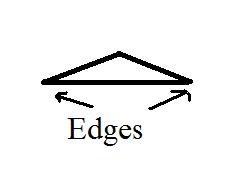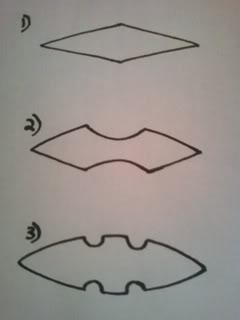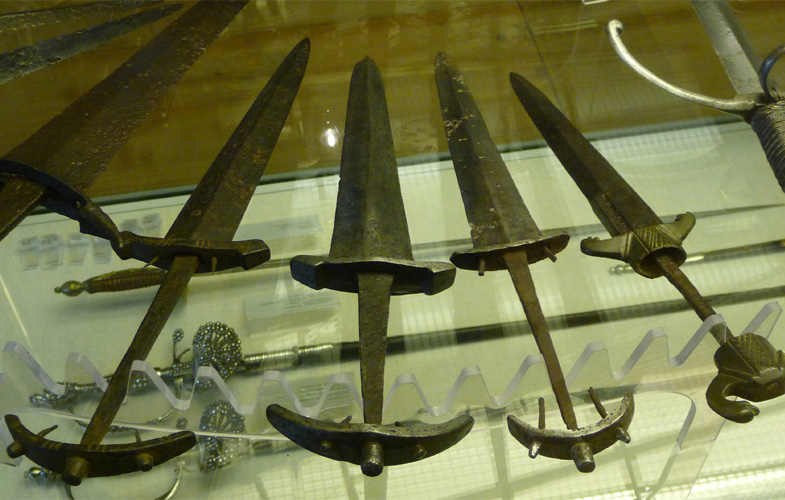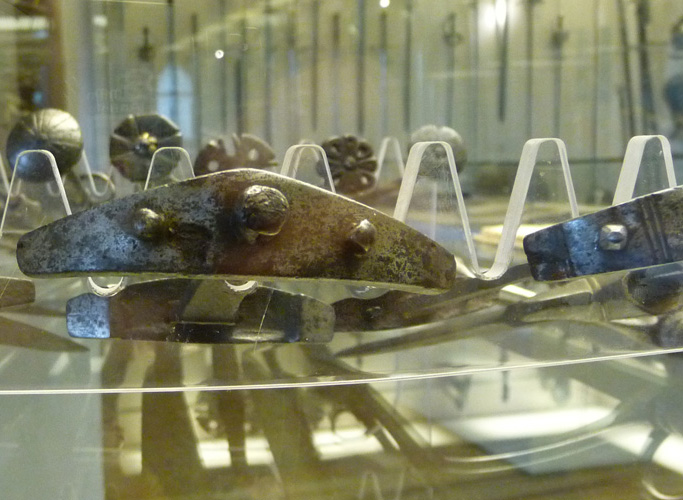
Most folks are familiar with single-edged triangular section blades. But there are also some daggers with double-edged blades with triangular cross-sections (see crude attached depiction). Some of these have a fuller or two on the same face as the mid rib (top of my image). What's on the back side (bottom)? Is it also fullered or is it flat or concave or something else?
 Attachment: 4.69 KB
Attachment: 4.69 KB


Hi Chad,
Have you seen items of this design that are in our focus time period? I've handled a few modern daggers that were hollow ground on the "back", and I believe some of Michael Pearce's tactical blades have zones where the blade's cross-section is flat on the back just as you've illustrated. I've never knowingly seen a historical blade like that, I'd be interested to learn that there were 'tho.
Have you seen items of this design that are in our focus time period? I've handled a few modern daggers that were hollow ground on the "back", and I believe some of Michael Pearce's tactical blades have zones where the blade's cross-section is flat on the back just as you've illustrated. I've never knowingly seen a historical blade like that, I'd be interested to learn that there were 'tho.
| Eric W. Norenberg wrote: |
| Hi Chad,
Have you seen items of this design that are in our focus time period? I've handled a few modern daggers that were hollow ground on the "back", and I believe some of Michael Pearce's tactical blades have zones where the blade's cross-section is flat on the back just as you've illustrated. I've never knowingly seen a historical blade like that, I'd be interested to learn that there were 'tho. |
Sure. There are at least 14 daggers of the 13th and 14th centuries in the Schweizerisches Landesmuseum in Zurich. Unfortunately, the catalogue of them doesn't show the back of the blades.
Silly question - how do you know the cross section is triangular if you haven't seen the back of the blade?
cheers,
Pierre
cheers,
Pierre
| Pierre T. wrote: |
| Silly question - how do you know the cross section is triangular if you haven't seen the back of the blade?
cheers, Pierre |
Because the catalogue has rudimentary cross-section drawings for each item indicating if it is diamond, square, single-edged triangular, double-edged triangular, etc. section.
Ah I see, thanks.
I have no idea, but it's certainly a very valid question to be asking. Would it be possible to send a message of some sort to the museum and ask?
cheers,
I have no idea, but it's certainly a very valid question to be asking. Would it be possible to send a message of some sort to the museum and ask?
cheers,
| Pierre T. wrote: |
| Ah I see, thanks.
I have no idea, but it's certainly a very valid question to be asking. Would it be possible to send a message of some sort to the museum and ask? cheers, |
That's always possible, though I hate bugging busy museum professionals unnecessarily. If I can't get the answer here, I will probably try that, though.
Chad, from what I´ve seen I think that those short and wide basilards with triangular sectioned blades tend to have flat back sides.
Some later period triangular sectioned daggers I´ve seen have had all bevels hollow ground. hey tend not to be symmetrical triangles in section, but have wide back, and one bevel narrower than the other on the front. Same diameter for hollow grinding is used for all bevel, I believe.
Mind you, I have only seen a handful of these blades first hand. There is probably variation to be found in the material.
Some later period triangular sectioned daggers I´ve seen have had all bevels hollow ground. hey tend not to be symmetrical triangles in section, but have wide back, and one bevel narrower than the other on the front. Same diameter for hollow grinding is used for all bevel, I believe.
Mind you, I have only seen a handful of these blades first hand. There is probably variation to be found in the material.
| Peter Johnsson wrote: |
| Chad, from what I´ve seen I think that those short and wide basilards with triangular sectioned blades tend to have flat back sides.
|
Peter,
Thanks for the info. :) Would examples that are fullered on the "front" side tend to be fullered on the back or would the fullers onlybe on the front side?
Chad
From what I remember, they are flat on the back side, even if fullered on the front side.
- Hmmm.
As I write this I get uncertainall of a sudden.
I must go check to make sure.
What is the flat back, may have a very shallow hollow grind from edge to edge. Very shallow: 1 mm deep or so.
I must also double check on the fullers.
Sorry.
I thought I knew.
Back to square one.
<:-/
- Hmmm.
As I write this I get uncertainall of a sudden.
I must go check to make sure.
What is the flat back, may have a very shallow hollow grind from edge to edge. Very shallow: 1 mm deep or so.
I must also double check on the fullers.
Sorry.
I thought I knew.
Back to square one.
<:-/
I have a silly question also.
I'm wondering why the fullers would not be included in the cross section drawings in the catalog?
Here's some quick drawings I did of the cross sections of three of my swords:

The first is of very flattened diamond cross section, the second the sort of flattened oval with single, wide shallow fuller, and the third of very beefy oval cross section with two parallel fullers running about two thirds of its length. These are just crude drawings, but the fullers are such important parts of the cross section that without them the drawings are woefully inadequate. The first has no indentations and just lines, because it has no fullers and the other two, without the indentations would misrepresent the actual cross section of the blades.
So my silly question, better stated, would be: How can a museum catalog justify not including such important features as fullers in cross sectional drawings when these features are of the profoundest importance in any cross section of a sword blade?
I'm wondering why the fullers would not be included in the cross section drawings in the catalog?
Here's some quick drawings I did of the cross sections of three of my swords:

The first is of very flattened diamond cross section, the second the sort of flattened oval with single, wide shallow fuller, and the third of very beefy oval cross section with two parallel fullers running about two thirds of its length. These are just crude drawings, but the fullers are such important parts of the cross section that without them the drawings are woefully inadequate. The first has no indentations and just lines, because it has no fullers and the other two, without the indentations would misrepresent the actual cross section of the blades.
So my silly question, better stated, would be: How can a museum catalog justify not including such important features as fullers in cross sectional drawings when these features are of the profoundest importance in any cross section of a sword blade?
| Quote: |
| So my silly question, better stated, would be: How can a museum catalog justify not including such important features as fullers in cross sectional drawings when these features are of the profoundest importance in any cross section of a sword blade? |
I can't answer why a famous author of the catalogue for a major museum's collection chose to do that decades ago when the book was put together. Maybe it was the author's decision to keep it simple. Maybe the publisher didn't generate specific enough illustrations. Maybe the cross-sections of some of these are more complex than a single drawing can convey.
These "silly questions" (your words) are pretty off-topic to this thread and don't help me get an answer to the question I posed, unfortunately. :) There are many inadequacies in many museum catalogues and it must be remembered that the museum's purpose and goal for the catalogue might be very different from ours. In fact, they may not have the modern replica collector in mind at all when making the catalogue.
| Chad Arnow wrote: |
|
Sure. There are at least 14 daggers of the 13th and 14th centuries in the Schweizerisches Landesmuseum in Zurich. . |
Could you tell me the full title and author's name ? I don't think I have this calatogue in my collection.
| Michal Plezia wrote: |
| Could you tell me the full title and author's name ? I don't think I have this calatogue in my collection. |
"Waffen im Schweizerischen Landesmuseum - Griffwaffen I" by Hugo Schneider ISBN 3-280-01251-1
Publisher: Orell F ssli Verlag Z rich 1980
Now can anyone please tell me what's on the back of these things? :)
| Peter Johnsson wrote: |
| From what I remember, they are flat on the back side, even if fullered on the front side.
- Hmmm. As I write this I get uncertainall of a sudden. I must go check to make sure. What is the flat back, may have a very shallow hollow grind from edge to edge. Very shallow: 1 mm deep or so. I must also double check on the fullers. Sorry. I thought I knew. Back to square one. <:-/ |
Peter,
Thanks for the info. I'd love to hear any info you might have on these.
Hello Chad,
I had the opportunity to pay a visit to the Reichsstadtmuseum Rothenburg ob der Tauber. There were two Basilards with a triangular blade on display in the glass cases, and if you got dowm on your knees you could see the flat side of the blade. They are really just flat, plain steel, no fuller, no decoration, as Peter said.
I tried to take pictures thinking of your question, but they are not very good, sorry for that.
An interesting detail, I think, is that the upper (?) guard is similarly shaped as the blade, somehow flattened on one edge.
I hope this is helpful.
Kind regards,
Markus
 Attachment: 145.32 KB
Attachment: 145.32 KB

"other" side
 Attachment: 161.23 KB
Attachment: 161.23 KB

"frond" side
 Attachment: 135.33 KB
Attachment: 135.33 KB

guard
I had the opportunity to pay a visit to the Reichsstadtmuseum Rothenburg ob der Tauber. There were two Basilards with a triangular blade on display in the glass cases, and if you got dowm on your knees you could see the flat side of the blade. They are really just flat, plain steel, no fuller, no decoration, as Peter said.
I tried to take pictures thinking of your question, but they are not very good, sorry for that.
An interesting detail, I think, is that the upper (?) guard is similarly shaped as the blade, somehow flattened on one edge.
I hope this is helpful.
Kind regards,
Markus

"other" side

"frond" side

guard
Chad, I have a small modern dagger with double edges, but three sides. No fullers, though. All three sides are deeply hollow ground. I think it's a Fury brand knife.
Markus,
Thanks for these pics. :) Do you know the dating on these and if they fit the late 13th-early 14th century date range I'm looking at?
Thanks for these pics. :) Do you know the dating on these and if they fit the late 13th-early 14th century date range I'm looking at?
Hello Chad,
The Museum dates them to the early 16th century, but there are other items on display which are - in my opinion - not dated correctly. For example, the sword below is dated 1150 to 1225, but the thrusting orientated blade style suggests a later date, I suppose (please correct me if I am wrong).
So, if you ask me, these daggers may well be 14th century, concerning similarities to other examples of basilards in various museums (Zürich, for example. And there is a huge ring hilted dagger/basilard found in the ruins of Tannenberg Castle which was destroyed in 1399, with the same style of cross guard). But I am not an expert.
Best wishes,
Markus
 Attachment: 81.21 KB
Attachment: 81.21 KB

Sword on display in the Reichsstadtmuseum Rothenburg ob der Tauber
The Museum dates them to the early 16th century, but there are other items on display which are - in my opinion - not dated correctly. For example, the sword below is dated 1150 to 1225, but the thrusting orientated blade style suggests a later date, I suppose (please correct me if I am wrong).
So, if you ask me, these daggers may well be 14th century, concerning similarities to other examples of basilards in various museums (Zürich, for example. And there is a huge ring hilted dagger/basilard found in the ruins of Tannenberg Castle which was destroyed in 1399, with the same style of cross guard). But I am not an expert.
Best wishes,
Markus

Sword on display in the Reichsstadtmuseum Rothenburg ob der Tauber
Hello Chad,
I remembered that I had another report of one dagger wich probably has a triangular cross section somethere in my computer. It is - or was - in the Deutsches Historisches Museum in Berlin, but not on display. I have one picture and a description, that approximately translates as follows:
"Double edged blade with a central ridge on one side, which transforms into a plane surface in the upper half of the blade."
The dagger is dated to the 14th century. And a ridge on only one side. I hope this will be helpful.
Kind regards,
Mark
 Attachment: 81.96 KB
Attachment: 81.96 KB
[ Download ]
I remembered that I had another report of one dagger wich probably has a triangular cross section somethere in my computer. It is - or was - in the Deutsches Historisches Museum in Berlin, but not on display. I have one picture and a description, that approximately translates as follows:
"Double edged blade with a central ridge on one side, which transforms into a plane surface in the upper half of the blade."
The dagger is dated to the 14th century. And a ridge on only one side. I hope this will be helpful.
Kind regards,
Mark
[ Download ]
Page 1 of 1
You cannot post new topics in this forumYou cannot reply to topics in this forum
You cannot edit your posts in this forum
You cannot delete your posts in this forum
You cannot vote in polls in this forum
You cannot attach files in this forum
You can download files in this forum
All contents © Copyright 2003-2006 myArmoury.com — All rights reserved
Discussion forums powered by phpBB © The phpBB Group
Switch to the Full-featured Version of the forum
Discussion forums powered by phpBB © The phpBB Group
Switch to the Full-featured Version of the forum